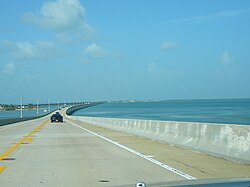
The Overseas Highway is a 127.5-mile (205.2 km) highway carrying U.S. Route 1 (US 1) through the Florida Keys. Large parts of it were built on the former right-of-way of the Overseas Railroad, the Key West Extension of the Florida East Coast Railway. Completed in 1912, the Overseas Railroad was heavily damaged and partially destroyed in the Labor Day Hurricane of 1935. The Florida East Coast Railway was financially unable to rebuild the destroyed sections, so the roadbed and remaining bridges were sold to the State of Florida for $640,000.


The original construction of the Overseas Highway used many of the bridges of the former railroad, including truss bridges, where the roadway was built on top of the trusses. "Contract for building 18 bridges on the new Overseas Highway to Key West was awarded to Cleary Brothers Construction Co. of West Palm Beach last week [late April 1942], calling for completion of all bridge construction work on sections of the highway within the overseas road and bridge toll district, on the abandoned foundations of the old Florida East Coast railway line." Most of these older bridges built for railroads have been replaced by more modern bridges that are able to accommodate more than two lanes of traffic. The highway included the Seven Mile Bridge, the Bahia Honda Bridge and the Long Key Bridge (although these three original bridges are no longer open to vehicular traffic, except for part of Seven Mile Bridge, they are listed on the National Register of Historic Places and are currently used as fishing piers).
From its opening on March 29, 1938, until the destruction by fire of the Card Sound Bridge in 1944, the Overseas Highway also had the signed designation State Road 4A; after the realignment in 1945 to its current entry onto Key Largo along the old railroad right-of-way (the new segment of Overseas Highway, from Florida City to Key Largo is known locally as "the 18 Mile Stretch"), it received the unsigned designation State Road 5, the same as the entirety of US 1 south of Jacksonville at that time.
Portions of the road were tolled until April 15, 1954; toll booths were located on Big Pine Key and Lower Matecumbe Key. Pigeon Key, roughly the midway point of the Seven Mile Bridge, served as the headquarters for the "Overseas Road and Toll District." The toll for automobiles was$1, plus 25 cents per passenger.
One of animated television's Wacky Races was The Overseas Hi-Way Race, which first aired on December 28, 1968, on CBS, covering the entire actual route from Key Largo to Key West. While Long Key was correctly portrayed, most of the other in-between keys were given fictional names, and Sombrero Key was actually five miles south of the highway in open water, according to the Florida Keys–East map.
The entire roadway of the Overseas Highway was substantially rebuilt in the 1980s. In recent years, Pigeon Key was used by the University of Miami as an oceanography laboratory, but current efforts to restore the buildings on the island have resulted in the establishment of a railroad museum there. The newer Seven Mile Bridge does not have direct access to Pigeon Key; people going there must walk on 2.2 miles (3.5 km) of the original Seven Mile Bridge from its northern end on Knight's Key, or take a shuttle bus, to reach the island.
